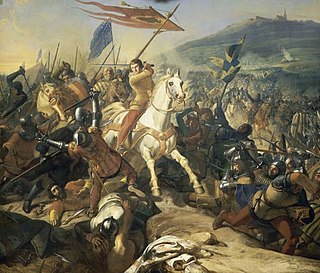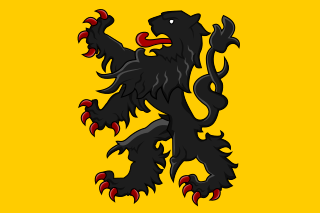Treaty of Paris may refer to one of many treaties signed in Paris, France:

Nord-Pas-de-Calais ; Picard: Nord-Pas-Calés); is a former administrative region of France. Since 1 January 2016, it has been part of the new region Hauts-de-France. It consisted of the departments of Nord and Pas-de-Calais. Nord-Pas-de-Calais borders the English Channel (west), the North Sea (northwest), Belgium and Picardy (south). Until the 17th century, the history of the North was largely in common with the history of Belgium, that of a land that "for almost a thousand years served as a battlefield for all of Europe." The majority of the region was once part of the historical Southern Netherlands, but gradually became part of France between 1477 and 1678, particularly during the reign of king Louis XIV. The historical French provinces that preceded Nord-Pas-de-Calais are Artois, French Flanders, French Hainaut and (partially) Picardy. These provincial designations are still frequently used by the inhabitants. The former administrative region was created in 1956 under the name "Nord" and maintained that name until 1972 when "Pas-de-Calais" was added. This remained unchanged until its dissolution in 2016.

Joan, often called Joan of Constantinople, ruled as Countess of Flanders and Hainaut from 1205 until her death. She was the elder daughter of Baldwin IX, Count of Flanders and Hainaut, and Marie of Champagne.

Margaret, often called Margaret of Constantinople, ruled as Countess of Flanders during 1244–1278 and Countess of Hainaut during 1244–1253 and 1257–1280. She was the younger daughter of Baldwin IX, Count of Flanders and Hainaut, and Marie of Champagne.

Enguerrand de Marigny, Baron Le Portier was a French chamberlain and minister of Philip IV.

Guy of Dampierre was the Count of Flanders (1251–1305) and Marquis of Namur (1264–1305). He was a prisoner of the French when his Flemings defeated the latter at the Battle of the Golden Spurs in 1302.

The County of Artois was a historic province of the Kingdom of France, held by the Dukes of Burgundy from 1384 until 1477/82, and a state of the Holy Roman Empire from 1493 until 1659.

The Flemish peasant revolt of 1323–1328, sometimes referred to as the Flemish Coast uprising in historical writing, was a popular revolt in late medieval Europe. Beginning as a series of scattered rural riots in late 1323, peasant insurrection escalated into a full-scale rebellion that dominated public affairs in Flanders for nearly five years until 1328. The uprising in Flanders was caused by excessive taxations levied by the Count of Flanders Louis I and by his pro-French policies. The insurrection had urban leaders and rural factions, which took over most of Flanders by 1325.

Robert III, also called Robert of Béthune and nicknamed The Lion of Flanders, was the Count of Nevers from 1273 and Count of Flanders from 1305 until his death.

Louis II, also known as Louis of Male, a member of the House of Dampierre, was Count of Flanders, Count of Nevers, and Count of Rethel from 1346 to 1384, and also Count of Artois and Count of Burgundy from 1382 until his death. He was the son of Count Louis I of Flanders and the Countess of Burgundy and Artois, Margaret I of Burgundy, the youngest daughter of the King of France, Philip V the Tall.

The Battle of Mons-en-Pévèle was fought on 18 August 1304 between the French and the Flemish. The French were led by their king, Philip IV.

The Treaty of Athis-sur-Orge was a peace treaty signed on 23 June 1305 between King Philip IV of France and Robert III of Flanders. The treaty was signed at Athis-sur-Orge after the Battle of Mons-en-Pévèle and concluded the Franco-Flemish War (1297–1305).

Raoul II/III of Clermont-Nesle was Seigneur (Lord) of Nesle in Picardy (de), Viscount of Châteaudun (de), Grand Chamberlain of France and Constable of France.

The Brugse Belofte or Blindekens procession is a yearly Catholic parade held since 1304 in the Flemish city of Bruges (Brugge) on Assumption of Mary. In yearly remembrance of the safe homecoming of the craftsmen from the battle of Mons-en-Pévèle in 1304 against the French knights, a candle is brought by a procession to the church of Saint Mary of the Blinds.

The Franco-Flemish War was a conflict between the Kingdom of France and the County of Flanders between 1297 and 1305.

Philip of Chieti (1263–1308) was the 8th and youngest child of Guy, Count of Flanders and his first wife Matilda of Béthune.

Walloon Flanders was a semi-independent part of the County of Flanders, composed of the burgraviates of Lille, Douai and Orchies. It is sometimes referred to as Lille–Douai–Orchies. The population of the region speak Picardy dialects.

The County of Flanders was one of the most powerful political entities in the medieval Low Countries, located on the North Sea coast of what is now Belgium. Unlike its neighbours, such as the counties of Brabant and Hainaut, it was within the territory of the Kingdom of France. The counts of Flanders held the most northerly part of the kingdom, and were among the original twelve peers of France. For centuries, the economic activity of the Flemish cities, such as Ghent, Bruges and Ypres, made Flanders one of the most affluent regions in Europe, and also gave them strong international connections to trading partners.
The English expedition to Flanders (1297–1298) was an English expedition to Flanders that lasted from August 1297 until March 1298. King Edward I of England in an alliance with Guy, Count of Flanders, as part of the wider 1294–1303 Gascon War, led an English force to Flanders, hoping to form military alliances and support to lead a combined force against King Philip IV of France. The expedition was difficult and expensive for Edward, but enough of his allies went into action to gain a truce from the French. After a peace was reached with King Philip IV of France, Edward left Flanders in March 1298.
William Deken was a burgomaster of Bruges and leader of the 1323–1328 Flemish revolt against the count of Flanders and the King of France.















